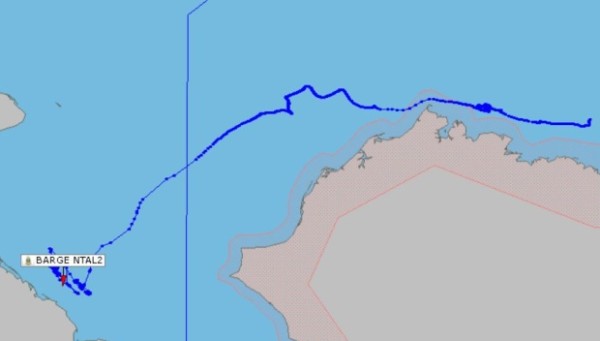WWF working to facilitate recovery of Canadian barge adrift in Arctic waters
In October 2014, a barge owned by Canadian company Northern Transportation Company Ltd. (NTCL) lost its tow on the way to Tuktoyaktuk, NT, and has been drifting through the Chukchi Sea along the Alaskan coastline. As of last month the Natl II had travelled over 2,200 km and recently wandered into Russian territory.
While the barge is carrying a relatively small amount of fuel (about 3,500 litres of low-sulfur diesel), its current location – about 72 km off the Russian coast – is cause for concern, as it is close to key Pacific walrus habitats near the Vankarem peninsula. However, Russian authorities have yet to locate the Natl II from aerial surveys, likely due to bad weather conditions and the possibility that the barge is covered with ice.
Last week, WWF-US and WWF-Russia contacted NTCL to discuss possibilities for recovering the Natl II. The company claims it has been unable to take action over the winter due to heavy ice in the region.
Now that the barge has floated into politically sensitive waters, WWF has taken on the role of facilitating the exchange of information, including the vessel’s trajectory, between U.S. agencies (the U.S. Coast Guard and the State of Alaska) and their Russian colleagues in the State Marine Pollution Control, Salvage and Rescue Administration of the Russian Federation (SMPCSA).
But the harsh Arctic environment leaves little time to waste. The path this barge has taken serves as a real-life account of WWF-Canada’s Oil Spill Trajectory Modelling (arcticspills.wwf.ca), showing how an oil spill in the Beaufort Sea would move in much the same way along the coast. Clearly a floating barge has far fewer environmental consequences, but it is imperative that Arctic nations see this as a wake-up call for improving cooperation in the event of a disaster.
As Alexey Knizhnikov, head of WWF-Russia’s Extractive Industries Programme said in a recent press release: “States sharing these waters need to drastically improve their collaboration in resources and emergency response capabilities. It is necessary to have protocols for timely and efficient exchange of information and for coordinated actions by different interested parties.”
WWF’s conservation focus can play a positive role in bridging the gap when current events make this kind of collaboration difficult. In the past several weeks, WWF-Russia has been discussing a potential recovery operation for the barge with the SMPCSA. They, along the WWF-US Arctic Field Program, have also been in touch with NTCL to inform them that Russian authorities plan to recover the barge when weather improves. As far as WWF is aware, NTCL has not contacted Russian authorities, even though they have said publically that they plan to recover the Natl II later this spring.
There is reason to argue that WWF’s role in this ordeal should have been played by the Arctic Council, a body made up of representatives from all eight Arctic states and six indigenous organizations, whose mandate includes “promoting cooperation, coordination and interaction among the Arctic States.” Earlier this week, WWF’s Global Arctic Programme (GAP) sent a letter to the Council asking them to embrace these values and take immediate action on a coordinated recovery operation.
There are several lessons to be learned from the Natl II’s voyage along the Arctic coast. Increased communication between jurisdictions, and between industry and government agencies, is paramount when working in such a harsh and unpredictable climate. It is sheer luck that this vessel is carrying a fairly small amount of fuel, and has yet to run aground. The Arctic is unlikely to be as forgiving the next time around.


